Gunner and Bosun's Mate
Sydney Compston was the sight setter on 'B' gun at action stations but
acted as Bosun's Mate on normal duty (cruising stations or harbour
duty).
Venomous had four
bosuns mates; when not at action stations two were on the Port Watch
and two on the Starboard Watch. Sydney's role as Bosuns mate on
cruising stations was to be bridge messenger and engine telegraph
operator (passing the commands for engine speed down to the engine
room). The Quartermaster, an AB like Sydney, was the helmsman on
cruising stations and in charge of the gangway in port responsible for
access on and off the ship, and the Bosun's mate was his assistant.
Sydney was Bosun's mate on Port watch;
his Quartermaster was William H.
Nickless, J100855, known as "Tubby" (the nickname gives a clue to his
physique, see his photograph on right below). At action stations the ship would be steered by the Coxswain
(a CPO).
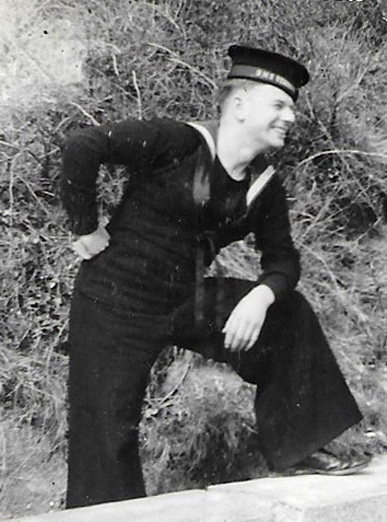 Sydney Compston on leave ashore Sydney Compston on leave ashore
All photographs are courtesy of Brian Compston
|
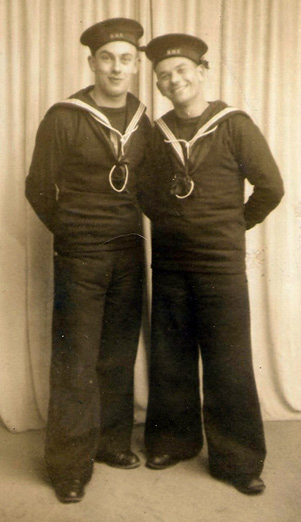
Dewy Jones (left) and Sydney Compston in 1939
A studio portrait while training
|
Sydney Compston and his Quartermaster William H. "Tubby" Nickless (on right)
Pier Cellars, Cawsand, near Plymouth Sound in 1942
|
Venomous
was a lucky ship and very few of her crew lost their lives but on 8
October 1941 "Teddy" Weekes, a reservist from Oxfordshire, was washed
overboard in an Atlantic storm.
Able Seaman William Elijah Reece Weekes (1902-41), RFR, D/J 91977, was
born at Radstock, Somerset, the son of Henry and Elizabeth Weekes and
was the husband of Edith Diana Weekes (nee Smith) of Oxford. He joined
the Navy as a boy sailor in 1918 and signed on for 12 years in 1920 and
had been an AB on HMS
Venomous since she came out of reserve in 1939. Sydney described how Teddy Weekes was washed overboard in
an Atlantic gale on 8 October 1941 (an officer's steward broke
his arm in the same gale when the ship rolled). In accordance with Naval tradition his
possessions were auctioned and the money raised sent to his widow.
George A. ("Arnie") Birkin, a gunlayer on “A” Gun, who joined
Venomous
at the same time as Teddy Weeks, made the successful bid for his
bosun’s call and his son, Malcolm Birkin, who lives in South Africa
still has it and sent the photograph below.
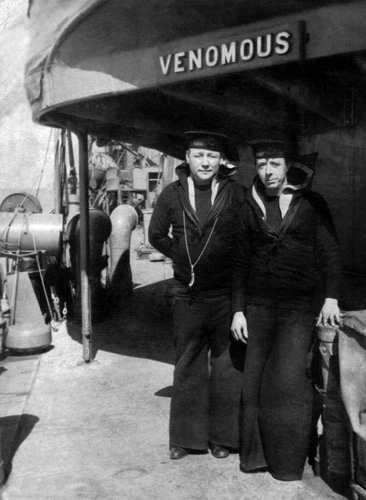 |
We know the names of three of the four Bosun's Mates in HMS Venomous in 1941. In addition to Sydney Compston and "Teddy" Weeks there was also AB Sydney T Charles J104538
photographed with his Call hanging round his
neck on the left.
His son, Arthur
Charles, followed his father into the Navy in 1963 and retired as a CPO
Naval Meteorologist. He met "little Sid" Compston, 5ft 6 inches tall, at the book launch at
Portsmouth
in 2010 and was told he worked for Arthur's father, "Big Sid", as a
runner on the gangway. "Big
Sid" was Regular Navy, born at Birmingham in 1906 who joined the Navy as a boy sailor at HMS Ganges in
1921 and signed on for 12 years in 1924. He was recalled in 1939 and spent 29 months in Venomous,
the longest period he served in any ship. He was tall and tubby in the
photograph on right as a "two badgeman" (8 years service) and took a
friendly interest in "Little Sid", the young HO rating he impressed by being able to roll a cigarette with one hand.

A Bosun's mate wore his Call on a light chain round his neck and
"piped" when he had a message to convey from the Quartermaster or the
officer of the watch. There were certain standard "pipes" with set
meanings such as "still" , a single long note used to bring hands on
the upper deck to attention when saluting passing ships, and "pipe
down" (eg lights out) with two high pips and a falling trill. The Call
was also used for "piping the side", saluting a senior officer coming
aboard or leaving.
| 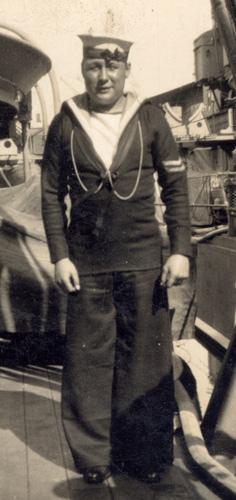
|
Royal Naval Commandos
Sydney Compston left
Venomous during the refit at Troon after the collision with HMS
Keppel on 12 November 1941. He was posted to the fast mine layer HMS
Abdiel
as part of a skeleton crew during a refit followed by a shore posting
at Plymouth before being transferred to the newly formed Royal Naval
Commandos.
The Royal Naval Commandos were responsible for establishing,
maintaining and controlling beachheads during amphibious operations.
Each of the 22 Royal Naval Commando units was commanded by a lieutenant
commander or commander and consisted of 10 officers and 65 ratings
organised into three parties, each of 25 men. AB Sydney Compston (D/JX 169001) was assigned to
Royal Navy Beach Commando Fox (RNBC
Fox) which trained at Inverkip Camp, June to July 1942.
The beach commandos were "key men in the complex machinery of
amphibious operations. Every man must be able to handle any weapon from
a revolver to a heavy gun, drive a vehicle from a motor cycle to a
heavy tank and handle any kind of boat from a dingy to a tank landing
craft. They rule the beach on any landing in enemy territory. Their
officer, the beach master, who may be merely a sub
lieutenant, is in absolute control of a landing. They land with the
very first wave of commandos or assault troops, make a swift 'recce' of
the beach to decide whether it was safe for the operation in hand. When
the whole area has been surveyed the beach master lies down at the
water's edge with his bodyguard alongside him facing inland, and
signals in the oncoming craft" (contemporary press report).
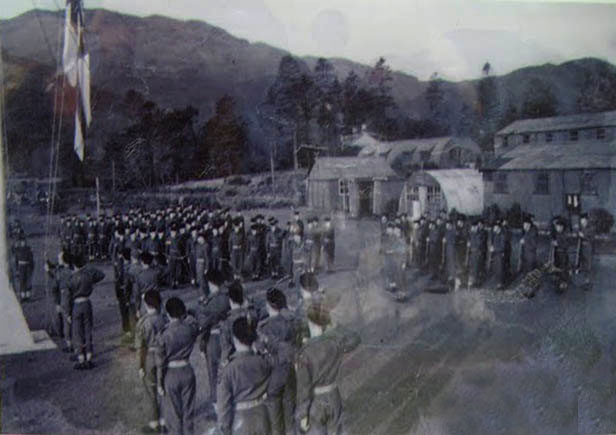
Sydney Compston and RNBC
Fox took part in the landings at Algiers and at Sicily. His old ship was not far away.
Venomous was escorting HMS
Hecla and
Vindictive to the invasion beaches at Algiers when
Hecla
was torpedoed in November 1942 and escorted the liners carrying the
troops and their LCT to Augusta in Sicily in July 1943. He returned
home on leave and married Wini
(Winifred) Brain, the girl he was stepping out with before the war when
they both worked at the British Federal Welder and Machine Company in
Dudley.
While
Venomous,
its engines shot, returned to Falmouth for a major refit lasting
several months the Royal Navy Commandos prepared for the landing on the
Normandy beaches. They trained at HMS
Armadillo, a shore base at Ardentinny on Loch Long, Scotland (see right). On 6th June 1944 RNBC
Fox was
assigned as Beach Masters body guard for Sword beach and Sydney was one
of the first people ashore on
Queen Red Beach (the eastern end of Sword). The
beach master at Sword was a 24 year old lieutenant, later
Rear Admiral "Teddy" Gueritz, who organised the flow of 30,000 troops and material into the
beachhead on the first day.

Early on in the morning Sydney was badly wounded by machine gun fire.
While lying wounded on the beach he witnessed Lord Lovat's piper, Bill
Millin, play the Royal Marine Commandos ashore:
"Lord
Lovat said this was going to be the greatest invasion in the history of
warfare and he wanted the bagpipes leading it. He said I was to play
and he would worry about the consequences later." Bill
Millin
walked up and down the beach at the water's edge playing a series of
tunes over the noise of battle despite the fact many of his comrades
were falling around him. He said he felt so helpless as he walked among
the wounded wanting medical help but for Sydney and many other soldiers
his playing boosted morale at a critical time. Piper Bill Millin is in
the foreground on the right in the MOD photograph of the Royal Marines
landing on Queen Red Beach.
The "Wound Certificate" completed by Sub Lt S.E. Willis RNVR of RNBC
Fox and signed by its CO, Lt Cdr W.G. Payne SANF, states that: "
while
crawling up Queen Red beach, Sword Area, they came under machine gun
fire. AB S. Compston was hit in the back whereupon he was moved to the
beach dressing station, and subsequently evacuated to the UK." For his actions on D-day Sydney was awarded the DSM.
After recovering from his wound he was scheduled to be transferred to
the far east but the war ended before that took place. He decided
he
didn't want to return to his pre-war factory job or work in the family
bakery business so he took advantage of a retraining scheme to become a
farm worker and moved from his native town of Sedgley to rural Hereford
and Worcestershire. Sydney and Wini had two children, Jean and Brian,
and had been married for more than sixty years when Wini died last
year. Jean lived in France and Brian returned home to look after his
elderly parents and drove Sydney to the
book launch at the RN Museum in Portsmouth on the 14 April 2010 where he was photographed with other veterans of HMS
Venomous and HMS
Hecla. He died later that year on the 17 November while convalescing in a care home after a fall.







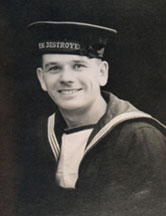
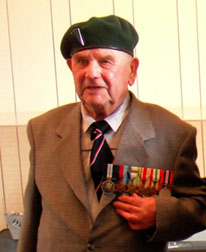
 Sydney Compston on leave ashore
Sydney Compston on leave ashore
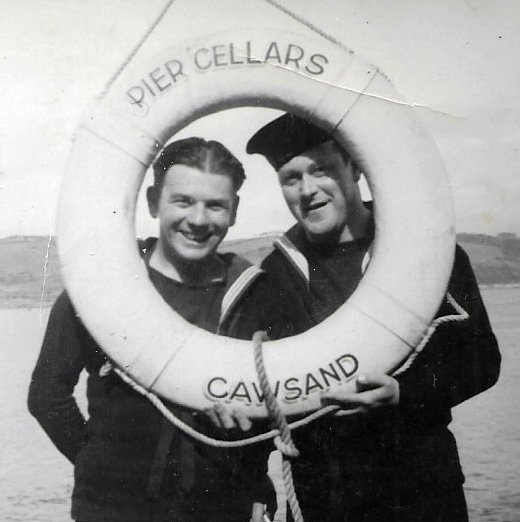



 Sydney Compston and RNBC Fox took part in the landings at Algiers and at Sicily. His old ship was not far away. Venomous was escorting HMS Hecla and Vindictive to the invasion beaches at Algiers when Hecla
was torpedoed in November 1942 and escorted the liners carrying the
troops and their LCT to Augusta in Sicily in July 1943. He returned
home on leave and married Wini
(Winifred) Brain, the girl he was stepping out with before the war when
they both worked at the British Federal Welder and Machine Company in
Dudley.
Sydney Compston and RNBC Fox took part in the landings at Algiers and at Sicily. His old ship was not far away. Venomous was escorting HMS Hecla and Vindictive to the invasion beaches at Algiers when Hecla
was torpedoed in November 1942 and escorted the liners carrying the
troops and their LCT to Augusta in Sicily in July 1943. He returned
home on leave and married Wini
(Winifred) Brain, the girl he was stepping out with before the war when
they both worked at the British Federal Welder and Machine Company in
Dudley.
